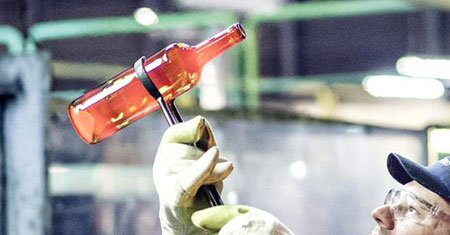Lack of accurate and enforceable standards often plagues glass bottle manufacturers during production. Many rely on the subjective opinions of workshop managers and packaging workers to assess product quality, which can result in lowering of standards and the release of defective glass bottles into the market, damaging the reputation and potentially compromising the safety of the end-user’s product.

Our factory has a complete and strict process to control product quality. We have professional QC to test glass bottles or other glass jars, and conduct inspections in several aspects such as technical requirements, experimental methods, inspection rules and signs, packaging methods and details, transportation and storage.
During the first 2 hours of production, if the mold temperature fails to reach the predetermined level, all the produced glass bottles will be deemed unacceptable and discarded. This results in a significant loss in terms of both time and cost, yet many factories overlook these strict requirements.

At our factory, each produced glass bottle undergoes a thorough inspection process, beginning with a visual assessment by the workshop director. The bottle’s weight and capacity are measured and any substandard products are promptly removed. We prioritize accuracy in capacity and size measurement, with errors kept within the tolerance range specified in the drawings. After passing the initial inspection, the bottle undergoes a two-hour annealing and cooling process, which gauges its ability to withstand temperature changes. This demanding test requires a spacious workshop, making it a challenge for smaller companies to conduct. The high standards of our workshop ensure the quality and durability of our products.

After annealing, the glass bottles undergo X-ray inspection to quickly detect any defects such as small breakpoints (less than 3mm), cracks, air bubbles, deviations in diameter, refractive power, surface flatness, thickness, and cleanliness. The use of advanced technology streamlines the inspection process, with a focus on testing the product’s hygiene standards. Our testing ensures that the levels of lead, cadmium, arsenic, and antimony in the glass bottles meet the stringent requirements set by GB 19778. This level of testing is often not performed by other factories.

After successfully passing the X-ray inspection, the glass bottles undergo further cooling until their temperature reaches approximately 40 degrees Celsius. Our quality control team randomly checks the bottle’s capacity to ensure it falls within the desired range. A matching lid is then placed and the seal is tested.
Defective bottles that fail to meet the standards are disposed of, while those that pass the test are packaged accordingly to the customer’s specifications, using cartons, sacks, or pallets. If Other packaging methods are utilized, the glass bottles are protected with plastic film as inner packaging.
Before delivery, the outer packaging must be checked for stability and damage, and precautions must be taken to prevent excessive vibrations during transportation. Proper handling and stacking techniques must be employed to avoid damage. Our professional warehousing ensures the safe storage of the products, protecting against moisture, fire, and theft before delivery.
For a stress-free purchasing experience, please contact us
